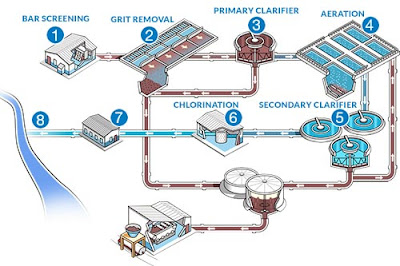How much Is waste Water treatment?
The term "wastewater" refers to water used and must be treated before it may be discharged into another body of water. This is done to prevent the wastewater from contributing to the contamination of other water sources. There are several different origins ofsewage. The wastewater treatment plant consists of everything and everything that is flushed down the toilet or washed down the drain.
Rainwater
and runoff, combined with various contaminants, make their way down street
gutters and, ultimately, wind up at a facility that treats wastewater. The
production of food and industry both contribute to the generation of
wastewater. Treatment of industrial wastewater, for example, might be complex.
In contrast,home wastewater treatment is often straightforward (though it is
becoming increasingly challenging to treat household waste due to the increased
amounts of pharmaceuticals and personal care products found in domestic
wastewater).
Who's Required with Making sure Water Is Treated
In
a manner comparable to the regulations about drinking water, the federal
government has delegated responsibility for wastewater treatment to several
provinces and territories. However, two federal statutes
could be relevant to wastewater treatment. The Fisheries Act makes it illegal
to dump poisonous chemicals into bodies of water where fish are found. The
Environmental Protection Act is a law that regulates the release of dangerous
compounds into the environment and gives the federal government the authority
to create restrictions on the usage of toxic substances.
Most
national, provincial, and territorial governments have enacted laws outlining
the criteria and procedures for Wastewater
treatment plants. The operators of wastewater treatment facilities are
required to seek permits or licences from the relevant province or territory
government. These permits may also demand different treatments or limit the
amount of effluent that may be discharged.
For
instance, all towns are obliged to have a strategy for managing liquid waste;
discharges are considered unlawful in the absence of an authorised plan. In
most cases, local administrations get financial assistance from provincial and
territorial governments to construct and maintain infrastructure.
Municipal
governments have direct oversight of the wastewater treatment process and have
the ability to develop programmes to eliminate toxic substances from the
wastewater treatment system. This programme mandates that all industrial,
institutional, and commercial facilities limit the number of specific
pollutants allowed to be discharged into sewers.
Making Legal for Withdrawal?
The
three available stages of Wastewater treatment plants are referred to as
primary, secondary, and tertiary levels of treatment, respectively. Most
municipal wastewater treatment facilities handle wastewater at the primary and
secondary levels, although some additionally treat wastewater at the tertiary
level. This schematic of the wastewater treatment plant displays the primary components.
However, the specific kind of treatment and the sequence in which it is
performed may differ from one treatment plant to another.
Screens
and settling tanks are used in the first phase of treatment to remove the vast
majority of the solids. Because solids account for roughly 35 percent of the
contaminants that need to be eliminated, this stage is of the utmost
significance.



.jpg)
Comments
Post a Comment